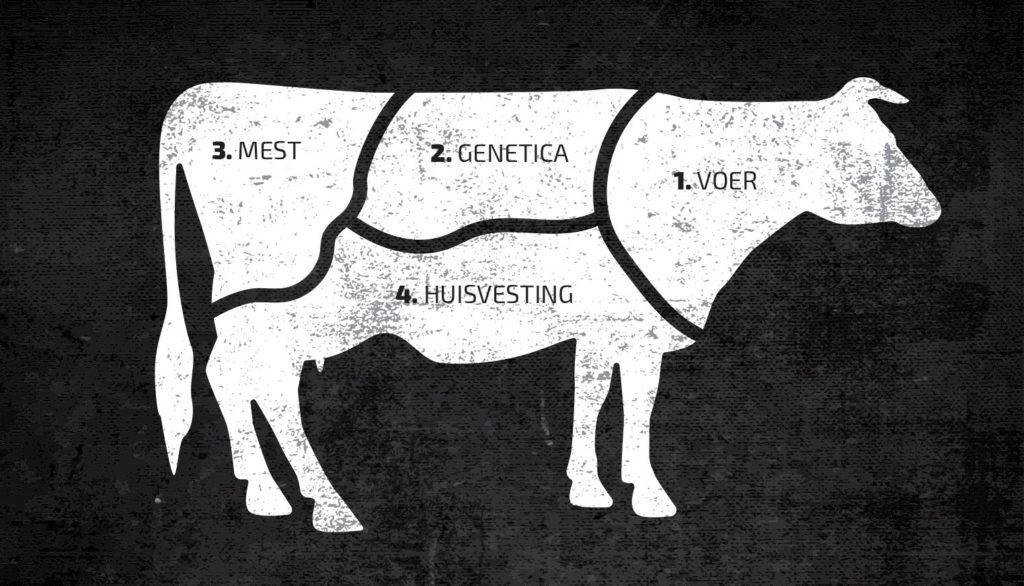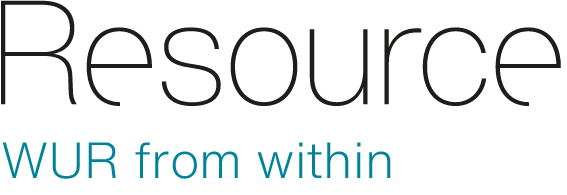
text Albert Sikkema illustration Geert-Jan Bruins
Cows are notorious for the greenhouse gases they produce. When they burp, fart and poo, they release methane. And when manure is used in fields, it produces nitrous oxide. Emissions of these two powerful greenhouse gases are often quantified by converting them to CO2 equivalents. Dutch dairy cows produce on average the equivalent of 1150 grams of CO2 per litre of milk. That needs to come down to 1020 grams per litre if we are to achieve the Dutch government’s climate targets by 2030.
We can manage that easily, reckons researcher Theun Vellinga of Wageningen Livestock Research, who specializes in animal production systems and climate change. In fact, he says emissions of greenhouse gases from dairy cows could be halved in the next few years. These are the ‘levers’ we need to pull to achieve that.
1 Feed
When cows digest grass in the rumen, it releases methane. If farmers feed their cows less grass and more maize, then less methane is produced, says Vellinga. But there are downsides too. ‘If a farmer starts growing a lot of maize, grassland has to be converted into arable fields, with organic compounds in the soil evaporating as a result. Maize cultivation can also be a blot on the landscape. So you can only go so far in replacing grass with maize.’
A less radical method for curbing methane production in cows is to add supplements to the fodder. ‘Many additives have been tried out, such as various herbs and nitrate,’ says Vellinga. The herbs did not have a lasting effect but the nitrate did. WUR experimental farm De Marke has run trials with the addition of low concentrations of nitrate to a diet of maize and silaged grass. This led to a drop of 30 to 40 per cent in methane emissions.
2 Genetics
You can breed cows that produce less methane, says Vellinga. To do that, you need to find out how efficiently cows digest their feed. That varies from one cow to the next, so cattle breeders can select bulls with efficient digestive systems. Researchers estimate that a targeted breeding programme could reduce methane production by one per cent per annum over the next few years. So over 20 years you could cut methane emissions by 20 per cent.
You could also use genetics and selection to push up Dutch cows’ milk yields further still, so that cows produce more milk per kilo of feed and therefore less methane per kilo of milk. But you need to be careful with that, says Vellinga. For years, Dutch dairy cows have been bred mainly to maximize production, a strategy that has resulted in cows with low resistance and little meat on their bones. ‘We mustn’t repeat the mistake of focusing too much on one property of the cow. We want robust cows in our fields that don’t fall ill easily and don’t need loads of antibiotics.’
3 Manure
When cow manure is stored, nitrous oxide and methane are released as bacteria convert organic compounds into these gases. But there is variation in this. For example, methane emissions from manure fall if the manure is cooled. Separating out the poo from the urine also has a beneficial effect on greenhouse gas production. There are other benefits from manure separation too, as it helps farmers apply precision fertilization because the urine contains nitrogen in particular and the solid manure has lots of phosphate.
4 Housing
In theory you could reduce the impact cows have on the climate further by keeping them in hermetically sealed barns with equipment to remove the methane and nitrous oxide. But such a hermetically sealed barn is expensive and it would mean keeping the cows indoors all the time. That is why Vellinga does not advocate this solution. Many dairy cows are currently kept in open barns with natural ventilation and room for the cows to move around. Many cows also spend part of the year outdoors. Those circumstances limit the extent to which we can capture or prevent greenhouse gas emissions, says Vellinga, but having cows in fields is valuable in its own right. ‘There are some things you can’t control as a farmer,’ says Vellinga, ‘but there is no cheaper way of removing grass from the land than a cow.’

‘Don’t forget the full picture!’
We won’t get there just by tinkering with the feed, the cow and the manure to reduce greenhouse gas emissions, claims Vellinga. He warns that we need to keep focused on the full picture. According to him, Dutch livestock farming is caught in the trap of optimization: how can we maximize milk production with as few inputs as possible and with minimum environmental impact? Animal manure legislation is a deciding factor. The phosphate rules reward farmers for producing as much milk per kilo of output phosphate as possible, while reducing phosphate excretion per kilo of milk gives farmers scope for more milk and more cows.
We need to wean ourselves off this approach, says Vellinga, because it comes at the expense of other aspects such as the landscape, biodiversity and animal welfare. ‘Dutch livestock farming makes full use of the phosphate quota but at the same time birds and insects are disappearing. The climate-friendly cow needs to be part of an approach to livestock farming that does justice to nature and the landscape and that closes cycles.’
That broader picture should encompass a business model for farmers, says the researcher. ‘We should pay farmers for their services to the landscape and ecosystems. That is possible for the climate-friendly cow too. You can set requirements for the reduction of greenhouse gases in livestock farming, identify appropriate measures and reward farmers who implement those measures. The guiding principle is giving the cow room rather than getting the most out of the beast. But there is no single right solution; farmers can combine perspectives.’
